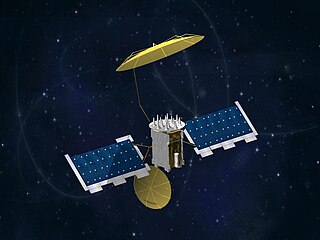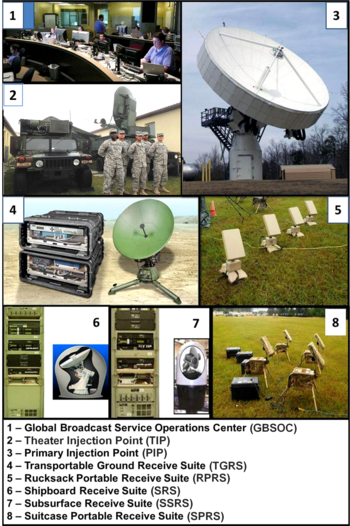
The Defense Information Systems Agency (DISA), known as the Defense Communications Agency (DCA) until 1991, is a United States Department of Defense (DoD) combat support agency composed of military, federal civilians, and contractors. DISA provides information technology (IT) and communications support to the President, Vice President, Secretary of Defense, the military services, the combatant commands, and any individual or system contributing to the defense of the United States.

Skynet is a family of military communications satellites, now operated by Babcock International on behalf of the United Kingdom's Ministry of Defence (MoD). They provide strategic and tactical communication services to the branches of the British Armed Forces, the British intelligence agencies, some UK government departments and agencies, and to allied governments. Since 2015 when Skynet coverage was extended eastward, and in conjunction with an Anik G1 satellite module over America, Skynet offers near global coverage.

Milstar is a constellation of military communications satellites in geosynchronous orbit, which are operated by the United States Space Force, and provide secure and jam-resistant worldwide communications to meet the requirements of the Armed Forces of the United States. Six spacecraft were launched between 1994 and 2003, of which only five were operational after launch; the third launch failed, both damaging the satellite and leaving it in an unusable orbit.
The Army Battle Command System (ABCS) is a digital Command, Control, Communications, Computers and Intelligence (C4I) system for the US Army. It includes a mix of fixed/semi-fixed and mobile networks. It is also designed for interoperability with US and Coalition C4I systems.

The Mobile User Objective System (MUOS) is a United States Space Force narrowband military communications satellite system that supports a worldwide, multi-service population of users in the ultra high frequency (UHF) band. The system provides increased communications capabilities to newer, smaller terminals while still supporting interoperability with legacy terminals. MUOS is designed to support users who require greater mobility, higher bit rates and improved operational availability. The MUOS was declared fully operational for use in 2019.
The Defense Information System Network (DISN) has been the United States Department of Defense's enterprise telecommunications network for providing data, video, and voice services for 40 years.

The Defense Satellite Communications System (DSCS) is a United States Space Force satellite constellation that provides the United States with military communications to support globally distributed military users. Beginning in 2007, DSCS began being replaced by the Wideband Global SATCOM system. A total of 14 DSCS-III satellites were launched between the early 1980s and 2003. Two satellites were launched aboard the Space Shuttle Atlantis in 1985 during the STS-51-J flight. As of 14 September 2021, six DSCS-III satellites were still operational. DSCS operations are currently run by the 4th Space Operations Squadron out of Schriever Space Force Base.

The Wideband Global SATCOM system (WGS) is a high capacity United States Space Force satellite communications system planned for use in partnership by the United States Department of Defense (DoD), Canadian Department of National Defence (DND) and the Australian Department of Defence. The system is composed of the Space Segment satellites, the Terminal Segment users and the Control Segment operators.

Advanced Extremely High Frequency (AEHF) is a constellation of communications satellites operated by the United States Space Force. They are used to relay secure communications for the United States Armed Forces, the British Armed Forces, the Canadian Armed Forces, the Netherlands Armed Forces and the Australian Defence Force. The system consists of six satellites in geostationary orbits. The final satellite was launched on 26 March 2020. AEHF is backward compatible with, and replaces, the older Milstar system and will operate at 44 GHz uplink and 20 GHz downlink. The AEHF system is a joint service communications system that provides survivable, global, secure, protected, and jam-resistant communications for high-priority military ground, sea and air assets.

The Military Satellite Communications Directorate is a United States Space Force organization headquartered at Los Angeles Air Force Base, California. It is one of several wings and other units that make up the Space and Missile Systems Center (SMC).

The Deployable Joint Command and Control system, commonly known as DJC2, is an integrated command and control headquarters system which enables a commander to set up a self-contained, self-powered, computer network-enabled temporary headquarters facility anywhere in the world within 6 – 24 hours of arrival at a location.

PM WIN-T is a component of Program Executive Office Command, Control and Communications-Tactical in the United States Army. PM WIN-T has been absorbed into PM Tactical Networks as Product Manager for Mission Networks.

USA-233, or Wideband Global SATCOM 4 (WGS-4) is a United States military communications satellite operated by the United States Air Force as part of the Wideband Global SATCOM program, launched in 2012. The fourth Wideband Global SATCOM satellite, it is the first WGS Block II satellite to be launched. It is stationed at 88.5° East in geostationary orbit.

USA-243, also known as WGS-5, is a United States military communications satellite. It was the fifth satellite to be launched as part of the Wideband Global SATCOM program and the second Block II satellite.

USA-204, or Wideband Global SATCOM 2 (WGS-2) is a United States military communications satellite which is operated by the United States Air Force as part of the Wideband Global SATCOM programme. Launched in 2009, it was the second WGS satellite to reach orbit, and operates in geostationary orbit at a longitude of 60° East.

USA-244, or Wideband Global SATCOM 6 (WGS-6) is a United States military communications satellite operated by the United States Air Force as part of the Wideband Global SATCOM programme. Launched in 2013, it was the sixth WGS satellite to reach orbit. It is stationed at a longitude of 135° West, in geostationary orbit. WGS-6 was procured by the Australian Defence Force for the U.S. Air Force, in exchange for participation in the programme.

The Joint Communications Support Element (Airborne) (JCSE) is a United States Department of Defense (DoD) standing joint force headquarters expeditionary communications provider that can provide rapid deployable, en route, early entry, and scalable command, control, communications, and computer (C4) support to the unified combatant commands, special operations commands, and other agencies as directed by the Joint Chiefs of Staff. On order, the JCSE can provide additional C4 services within 72 hours to support larger combined joint task force headquarters across the full spectrum of operations. JCSE is part of the Joint Enabling Capabilities Command (JECC), a subordinate command of the U.S. Transportation Command (USTRANSCOM).

USA-275, or Wideband Global SATCOM 9 (WGS-9) is a United States military communications satellite operated by the United States Air Force as part of the Wideband Global SATCOM programme. Launched in 2017, it was the ninth WGS satellite to reach orbit. It is stationed at a longitude of 135° West, in geostationary orbit. WGS-9 was procured by the United States Air Force.

USA-291, or Wideband Global SATCOM 10 (WGS-10) is a United States military communications satellite operated by the United States Air Force as part of the Wideband Global SATCOM programme. Launched in 2019, it was the tenth WGS satellite to reach orbit. It is in geostationary orbit. WGS-10 was procured by the United States Air Force.

Wideband Global SATCOM 11+, is a United States military communications satellite to be operated by the United States Space Force as part of the Wideband Global SATCOM Program. Scheduled for 2024, it is the eleventh WGS satellite and is expected to be in geostationary orbit. WGS 11+ was acquired by the United States Air Force.















